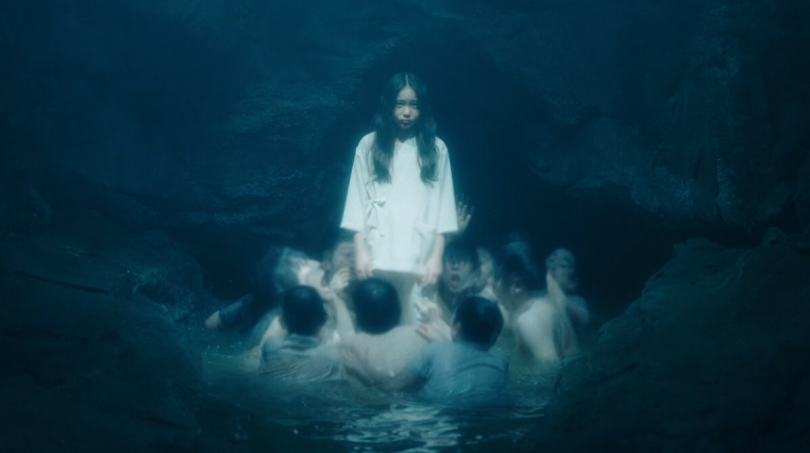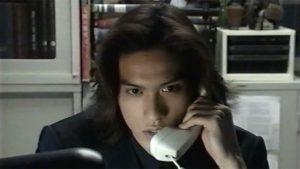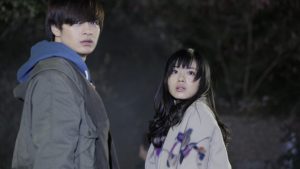Welcome back to our Halloween retrospective of the Ring franchise. Last time, we covered the original Ring Cycle from the late 1990s. Here in our second chapter, we shall be reviewing the subsequent Japanese instalments that have followed, including the original TV movie adaptation, two television series, and the sequels to both continuities (spawned from Ring and the retconned Spiral.)
Ring: Kanzenban (1995)
The very first adaptation of the novels, Ring: Kanzenban (“The Complete Edition”) is by far the most accurate to the source material. The trouble is that the film’s production and quality are just tepid. Released on Fuji TV as a television movie, Ring: Kanzenban is devoid of any nuance as a piece of storytelling. The whole escapade looks like it was filmed over a weekend, with awful cinematography, saturated lighting, and dreary acting from a cast who I hope were well paid. As it turns out the screenplay was written by Jōji Ida, who directed Spiral in 1998. That might explain the similar sense of mediocrity from both films, though Spiral is vastly better.
The movie does a decent job of adapting Ring, even if the end result is poorly made. Our protagonist is Kazuyuki Asakawa, a journalist who investigates the deaths of four teenagers including his niece, leading him to the cursed videotape and things go on from there. Kazuyuki is played by Katsunori Takahashi, who spends a majority of the movie looking uninvested and bored. In comparison, Yoshio Harada is a lot more energetic as Ryuji Takayama, portrayed closer to his book counterpart as an eccentric teacher with a controversial reputation.
Sadako Yamamura is portrayed by Ayane Miura, a former pin-up model who spends most of her screentime in the nude. In fact, whenever the plot feels like it is dragging, the film throws in some raunchy scenes that are way too graphic for television. This is explained in the Kanzenban title, as the “Complete Edition” refers to the inclusion of even more sex scenes, some of which reshot for the extended version.
Still, the movie does include some of the novel’s unique elements. For example, Sadako meets her demise after being assaulted by a doctor named Jotaro Nagao (Tomorowo Taguchi), who discovered Sadako was a hermaphrodite; a crucial plot point left out of every other adaptation. On the other hand, the frequent nudity and decision to throw in some incest between Sadako and her father really don’t do Ring: Kanzenban any favours. The raunchiness is probably why the movie has not had a new re-release since 1996.
Ring: The Final Chapter (1999)
Don’t be deceived by this television series’ title. This was not the final chapter of the Ring saga by a long shot. Produced in the wake of the 1998 film, the series blends elements from both the novels and films with muddled success. In some respects, the show is a respectable adaptation, even if it feels a little drawn out – so much that the cursed videotape’s deadline is extended from seven days to thirteen.
Toshirō Yanagiba plays Kazuyuki Asakawa, who is widowed, caring for his young son Yoichi. He performs the familiar sleuthing of his counterparts, until we learn the rumoured videotape is actually a popstar’s music video that hides subliminal messaging. Kazuyuki turns to Ryuji, who is played by Tomoya Nagase, a famed member of the Tokio musical group. Ryuji’s depiction is probably the most diverse take on the character, being overtly serious, broody, violent, and really likes slow, dramatic, shadowed turns towards the camera. The show chooses to take some unusual steps with the character, reimagining him as the older brother to the comatose Mai Takano (Akiko Yada), and is even revealed to be Sadako’s son.
The only character debatably more intolerable than Ryuji is Kazuyuki’s colleague Akiko Yoshino (Kotomi Kyono), a gender swap of a character from the novels. Yoshino flip flops between enduring bubbliness and just plain irritating. She is devoted to Kazuyuki, but her impulsiveness gets both her and Yoichi cursed, not to mention repeated murder attempts from other characters. A subplot involves Reiko Miyashita (Hitomi Kuroki), based on the Spiral character, a virologist and Kazuyuki’s friend, who studies the curse from a medical perspective.
In spite of being unnecessarily long, The Final Chapter is still an engaging watch, with good acting and a few plot twists. Toshirō Yanagiba carries a lot of the show’s intrigue and emotion, playing Kazuyuki straight as a determined father and friend who cares abundantly for those around him. It may be a flawed, often slow-paced show, but it is worth a watch if you have the time.
Rasen (1999)
The second season to Ring: The Final Chapter, Rasen is loosely based on the novel Spiral. Taking an absurd amount of liberties with the book, Rasen swaps out the first season’s cast, following a convoluted story that jumps here and there. In The Final Chapter, most of the subplots tied directly into the overall mystery and stakes. Rasen feels a little crowded with endless threads that feel arbitrary, especially when the show can’t make its mind up on what to focus on.
Mitsuo Ando, who is a depressed mortician in the book, is reimagined as a chummy teacher played by Goro Kishitani. His son Takanori drowned, leading to his wife Miwako (Risa Junna) being placed in a care home, unaware her son is dead. Ando has yet to fully deal with his grief, which is part of his character arc throughout the drama. The show hits the ground running with people dropping dead in an office block, the Ring Virus is on CD, Sadako is repeatedly resurrecting herself as clones of the recently deceased. There is a dramatic cliffhanger where it looks like the video is going to be broadcast live on television, but it bails on that just as quickly.
Akiko Yada reprises her role as Mai, wandering around the sidelines issuing warnings to the main characters. She then is killed offscreen by Sadako, who appears played by both Yada and Tae Kimura. In perhaps the season’s best drama, Sadako resurrects Takanori, tempting Ando to give her the virus CD to mend his broken family. Ando refuses, leading to a tense sequence where his lucid wife angrily confronts him when manipulated by Sadako. Ando ultimately accepts responsibility for Takanori’s death, prompting the couple to finally grieve together before a stunned Sadako’s eyes.
The primary threat of the series isn’t Sadako, but the King of Terror, a shadowy sociopath who manipulates events from out of sight. It is revealed that the madman was part of a social experiment run by pathologist Hiroshi Rikuta (Takashi Naito) which seems to have been based on the Stanford prison experiment. All of the lingering subplots in the series link back to this figure, who wishes to use Sadako’s virus to terrorise the whole world.
At times, watching the series can feel like a task, as several plot threads could have easily been cut for the sake of pacing. Thirteen episodes feels a little long, but Rasen still offers plenty of enjoyable scares, good acting, and a fair balance of drama and horror.
Sadako 3D (2012)
Twelve years after Ring 0, the surprise appearance of Sadako 3D was a welcome one. The film had a creative marketing campaign, but the film itself is a frustrating experience. A very loose adaptation of the novel S, the film is hinted to be a sequel to the retconned Spiral, making its place in the cinematic timeline a real headscratcher. It utilises very little of Sadako’s lore beyond her iconography. In fact, it uses its titular 3D gimmick in endless repetition whenever Sadako bursts from the nearest TV screen. Still, the movie does offer some new ideas to the franchise.
The cursed videotape has been reinvented as an online suicide video of artist Seiji Kashiwada (Yusuke Yamamoto), who plots to find the perfect host to resurrect Sadako. Anyone who watches the video will kill themselves shortly thereafter. Akane Ayukawa (Satomi Ishihara), a high school teacher, is in a happy relationship with Takanori Ando (Kōji Seto), hiding from a dark past. When one of her students apparently commits suicide, Akane comes across the video and is targeted by Sadako. It turns out Akane has her own suppressed psychic powers in the form of a sonic scream. Meanwhile, police detectives Koiso (Ryosei Tayama) and Nakagawa (Tsutomu Takahashi) investigate the strange string of deaths and hunt for Kashiwada, convinced he is alive.
The film’s scares feel lazy and cheap. The 3D effects are used sparingly whenever Sadako appears, or when broken glass flies at the screen. Jump scares plague the film, often used on the most trivial of things. Towards the end of movie, Nakamura randomly is afflicted by the curse, appearing before Koiso in a ghostly wig before shooting himself. Another character hangs himself, but the prop dummy used is so rubbish, it looks like a Halloween decoration.
Sadako kidnaps Takanori, so Akane and Koiso drive to the old well, now in the ruins of a shopping centre instead of a holiday resort. Kashiwada is revealed to have murdered numerous women who resemble Sadako and tossed them down the well as potential hosts. These corpses then climb out of the well as mutated, long-legged bug ladies who seem to be paying homage to the Xenomorphs. These leads to an extended chase sequence, with Satomi Ishihara doing a grand old job as the frightened final girl. Sadako is played by Ai Hashimoto, who delivers a performance that comes close to capturing Sadako’s literary personality, though still carries a sympathetic air. Oh, and she has glowing red eyes.
Ultimately, Sadako 3D is not the best film, though has a decent cast, attempts to take the story in a new direction, and there is some intrigue around Kashiwada’s motives.
Sadako 3D 2 (2013)
The follow up to Sadako 3D, its sequel solves issues with the last movie, going for a more sombre, atmospheric tone. Yet, by fixing its predecessors problems, it ends up causing its own with use of red herrings that have no substantial payoff to the film’s deeper mysteries.
Five years after the previous film, Akane and Takanori have a daughter named Nagi (Kokoro Hirasawa), a quiet, eerie child who seems to cause harm to those around her. With Akane “dead” and Takanori distant, Nagi’s upbringing is left to Takanori’s delicate sister Fuko (Miori Takimoto), who suffers from her own childhood trauma following her mother’s suicide. Nagi frightens Fuko, who investigates events of the first film to uncover the truth. The imprisoned Seiji Kashiwada claims that Nagi is Sadako’s child, the endgame of his plans. The film bounces back and forth between what the truth is, though it does a good job of keeping the audience guessing.
As it turns out, Kashiwada is wrong. Nagi was intended to be Sadako’s new vessel, but Akane put herself in a psychic coma to trap Sadako within her body. Nagi has visions of death, which turns out to be extremely traumatic for her. Nagi becomes threatened by a vengeful police officer, whose wife was killed by the curse, which is now reduced to a digital glitch that massacres a whole subway train, reminiscent of disturbing imagery of the 1995 sarin attack on Tokyo’s subways. Fuko sadly spends most of the movie utterly clueless to what is happening, at it isn’t until Nagi finally opens up does she mature enough to confront her neglectful brother Takanori.
The movie’s ending and plot twist is vague and confusing. The closing scenes reveal that Nagi is indeed a red herring, and there are several little girls running around who plot to spread the curse, though none of this is explained, since the film did not gain a sequel of its own.
Sadako vs. Kayako (2016)
I have previously discussed Sadako vs. Kayako in my Ju-On retrospective a year ago, but it is worth revisiting. What started as an April Fool’s joke and turned into an actual film, this crossover had a lot of potential. In some ways, the wacky marketing was more entertaining than the film. There are some good atmospheric scenes, particularly when revolving around the Ju-On characters, whilst it reminds us just how frightening both Sadako and Kayako can be.
Primarily Ring-heavy, two college students Yuri (Mizuki Yamamoto) and Natsumi (Aimi Satsukawa) stumble upon a version of the videotape, and, well, you know the drill. They call upon exorcist Keizo Tokiwa (Masanobu Ando) to help, who suggests neutralising the curse with another curse. Conveniently, the house of Kayako Saeki happens to be right around the corner, cursing new girl on the block Suzuka Takagi (Tina Tamashiro). Keizo brings the girls together – Natsumi being killed off earlier – to have Sadako (Elly Nanami) and Kayako (Runa Endo) duke it out in the ultimate horror deathmatch since Freddy vs. Jason. Unfortunately, the titular battle is reserved until the last fifteen minutes of the film and even then it is over relatively quickly.
To have two popular and powerful queens of horror together should have been something special, but the end result feels a little rushed and disappointing. In one corner, you have a powerful psychic who can alter biology and resurrect the dead, and in the other is an unstoppable reality warper with one hell of a grudge. Beyond a mild scuffle and an awesome head explosion, there is little versus to be found. The movie ends with both ghosts merging into one monstrosity, but this potential new evil is never resolved as the movie ends right when it starts to get good.
Sadako (2019)
The latest Japanese entry, Sadako returns to the original timeline of the Ring Cycle. Hideo Nakata returned to direct, having previously directed the first two films, as well as The Ring Two. Like previous films, it is liberally adapted from Koji Suzuki’s novel Tide, choosing to expand Sadako’s supernatural presence a little more, though the film feels periodically like a rehash of earlier instalments.
The plot revolves around two siblings, sensible psychologist Mayu Akikawa (Elaiza Ikeda), and her brother Kazuma (Hiroya Shimizu), a fame-starved vlogger who will do just about anything for views. This involves sneaking into a burnt out apartment where he has a ghostly encounter with Sadako. By coincidence, Mayu comes to care for an unnamed little girl (Himeka Himejima), who lived in the apartment, surviving an attempt by her disturbed mother to burn the place down – under the belief that child is a reincarnated Sadako. Kazuma soon disappears, whilst Mayu’s new psychic patient brings Sadako’s presence to the hospital. The only means to put an end to disappearances and hauntings is to return to the source of Sadako’s misery.
The film does offer potentially fresh ideas, once again trying to bring Sadako into the internet age. The cursed videotape is absent, a refreshing option where the film doesn’t attempt to rehash Sadako’s curse in a new form. The closest we get in turning Kazuma’s vlog into an online meme that is one of those videos that may or not exist. Instead, the film is more about breaking a cycle of terror and abuse that relates to both Sadako and the girl. I half expected Mayu to have a relatable backstory, but she is actually just your average joe. Mayu has more agency that previous protagonists, though her story mirrors those of Reiko Asakawa and Ayane. Kazuma manages to avoid being insufferable, but his ego pushes him to record an exploitive vlog that blows up in his face.
The only returning cast member is Hitomi Sato as Masami Kurahashi, still traumatised years after her friend Tomoko’s death at the beginning of Ring. Emotionally unhinged, Masami views Mayu as a friend, though takes any form of rejection hard. Her unwanted reunion with Sadako is certainly a highlight of the movie, even if Masami was originally a mere bystander. In terms of similar atmospheric tones and scares, Sadako is lacking, being rather mundane in its execution. The film didn’t require Hideo Nakata to replicate his previous successes, but it can be praised for attempting to go in a new direction, even if the end result is a little underwhelming.
The next Ring film, Sadako DX, is due for release in late October 2022. We shall review it at a later date. In our third and final volume, we shall be reviewing the South Korean film, The Ring Virus, and the American trilogy. Which is your favourite Ring film? Leave a comment below or on our Twitter feed.








